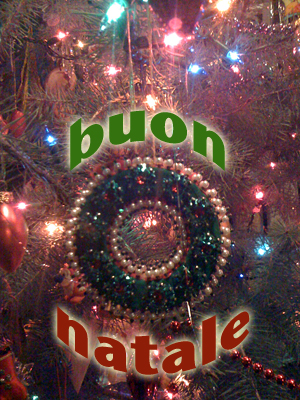Like the euro, panettone are ubiquitous throughout Italy now, with no particular regional association. But everywhere the panettone was, so was the local specialty, certosino, a flat, glossy spiced fruitcake glistening with translucent candied cherries and nuts. In the pasta shops, between the usual trays of eggy fresh tagliatelle were heaps of tiny, hand-pinched tortellini, the pride of Bologna, filled with a rich mixture of veal and mortadella and ready to be floated in golden capon broth to start the Christmas dinner.
In the butcher shops, fat zampone the size of a baby's pudgy arm were on proud display. There's no delicate way to describe zampone: it's a pig's trotter, bones removed, packed with a savory meat stuffing and then sewn back up so that it looks ready to walk. Simmered a long time, then served with lentils, it's a traditional dish in Emilia-Romagna, especially around New Year's.
In the sweet shops, there were shiny boxes of dreamy, hazelnut-layered Fiat Cremino and Fiat Noir chocolates, made by Majani, but also chunks of carbone, crunchy lumps of rock candy dyed black to look like coal. (It seems naughty Italian children are also in danger of getting coal for Christmas.) Santa Claus, that jolly toy-toting American immigrant, has made some inroads, but traditionally, gifts for children come not on Christmas Day but on Epiphany, delivered by a beneficent witch known as La Befana.
We saw her--or at least a convincing, black-shawled version of her--riding in a carriage through the streets of Bologna on the morning of January 6. A well-dressed older gentleman ahead of us, cellphone pressed to his ear, turned his head as she rode by. "Ah, ecco La Befana!" he said, in perfect seriousness, before resuming his conversation.
Bologna loves its salume (it is the home of mortadella, bastardized here into baloney) and its culatello, not to mention the sweet-salty proscuitto produced in nearby Parma. That Christmas, I learned the way to get the best proscuitto was to follow hard on the heels of the bossiest elderly lady customer in the shop. Once she'd picked out, after much discussion, the exact haunch of proscuitto she wanted out of the many in the shop, I'd hover in her wake. As soon as her purchase was wrapped up, I'd hustle to the counter, before the leg could be lifted off the slicer, and request a few etti (100 grams) of lo stesso (the same). (This technique can also be used very successfully re: smoked salmon in Jewish delis.)
Another tradition that really came into its own at this time of year was the aperitivi spread. No corner caffe-bar would dream of serving drinks without putting out a little free something to snack on. It could be just little squares of leftover panini and a bowl of olives, or a whole mini-buffet, but it's common throughout Italy in the evening. Only in Bologna does aperitivi happen before lunch, too.
Well, perche non? The holidays seemed like a great time to take advantage of this, especially when friends came to visit. It was a cultural mandate, after all. After a Christmas Eve morning spent browsing through churches (each with an extravagant creche on display), excellent chocolate shops, and tiny, fiercely bustling cheese stores (but giving the equine butcher shops--marked by the golden horse heads out front--a wide berth), we ducked into a nearby caffe for a couple glasses of prosecco. The counter was loaded with an especially lavish display of tasty little snacks for the taking--craggy chunks of parmesan and cubes of mortadella, proscuitto wrapped around the skinny bread sticks known as grissini, olives, sweet roasted red peppers, artichoke hearts, a hot cheese dip kept warm over a candle--and the perpetually chic Italians around us were happily munching. Behind the counter, one of the equally chic workers paused and held up her own glass of bubbles.
"Buon Natale!" she said, looking out over the bar. "Buon Natale a tutti!"
 Buon Natale!
Buon Natale!